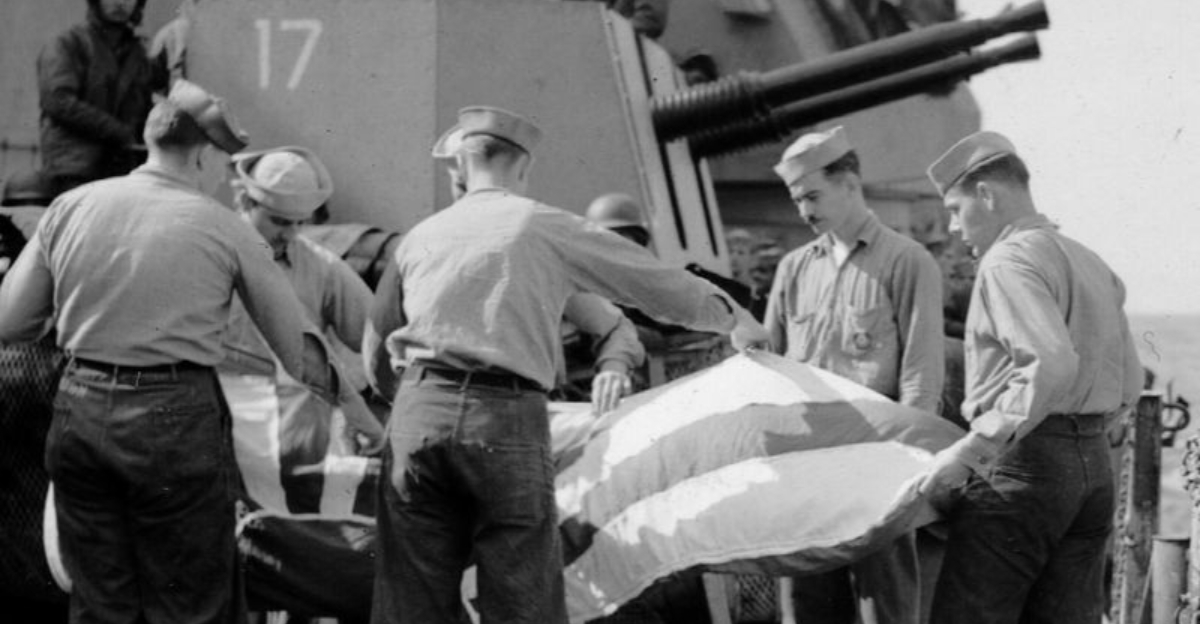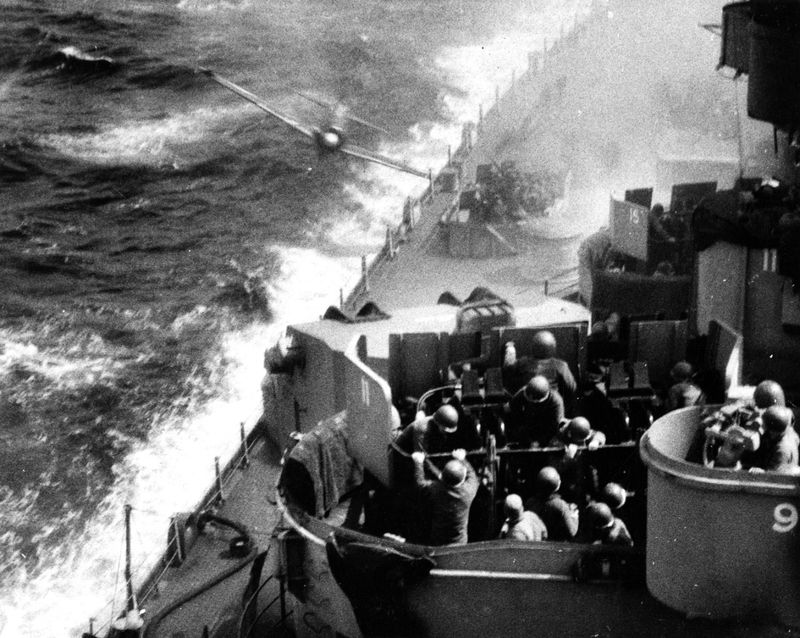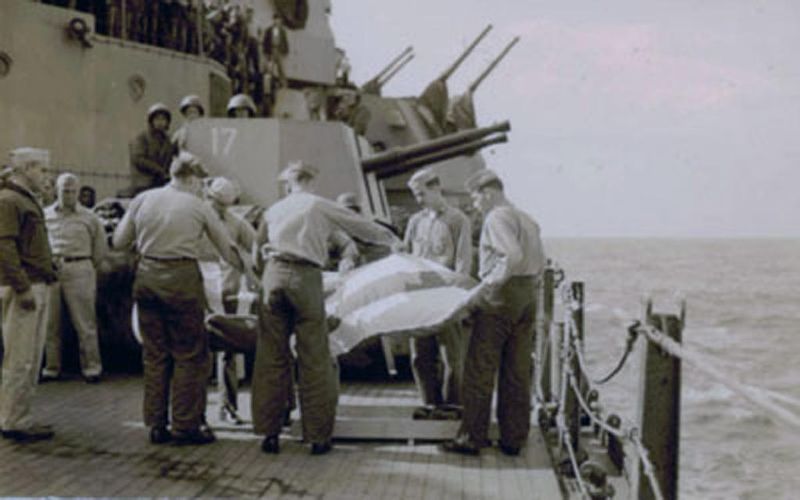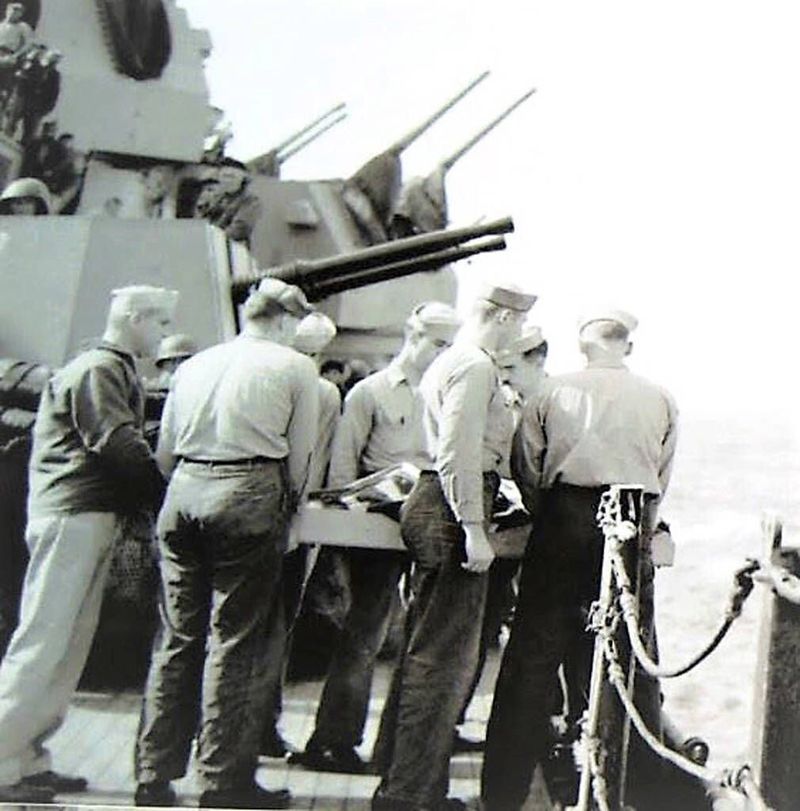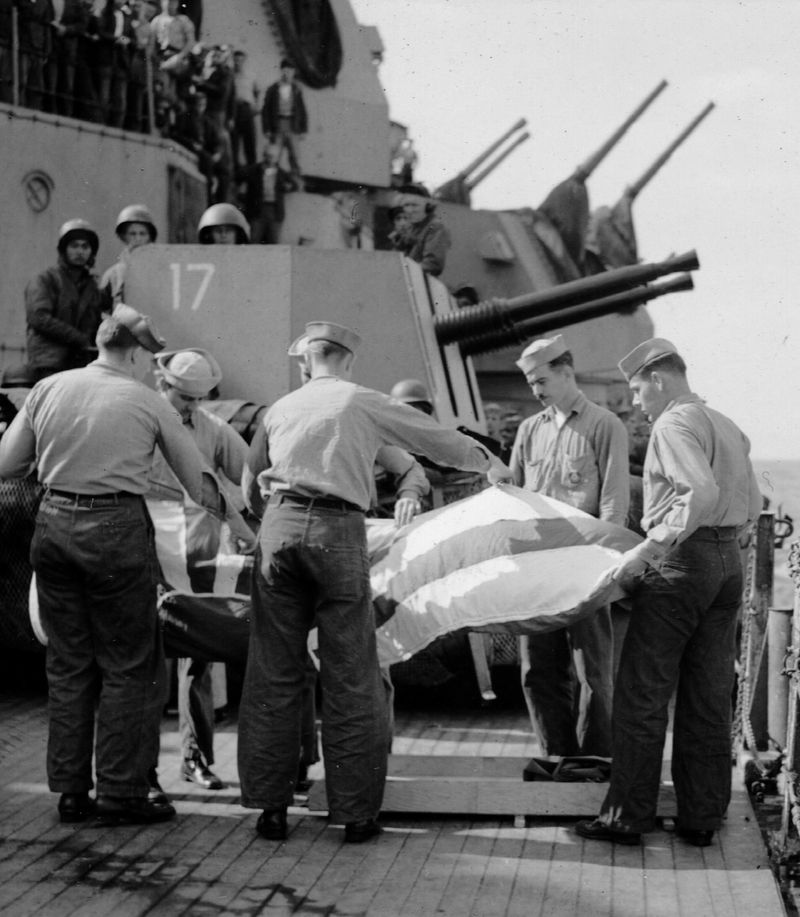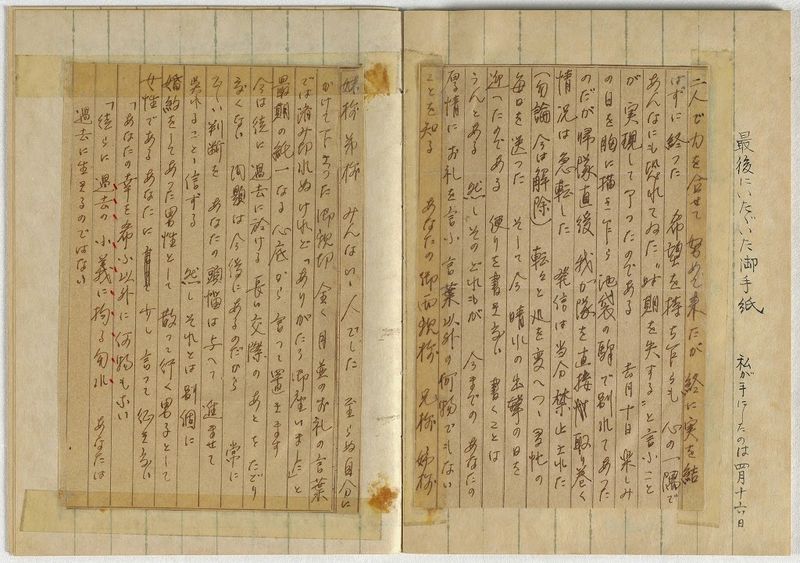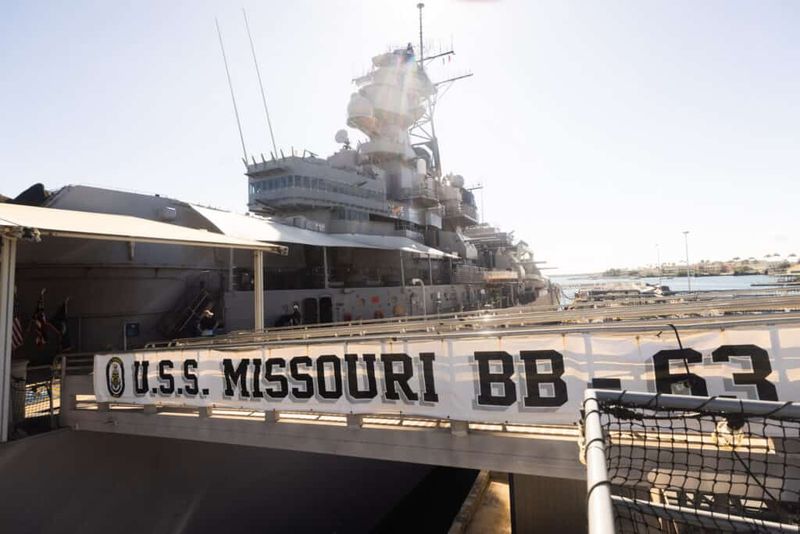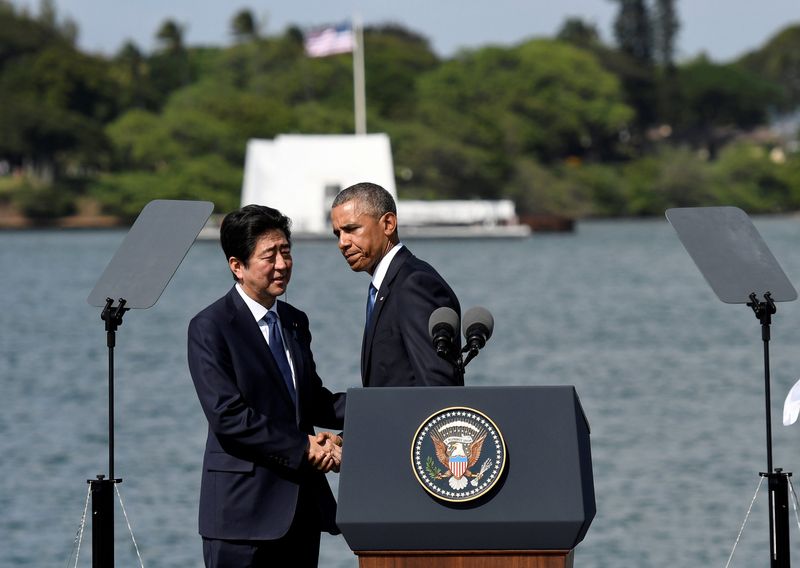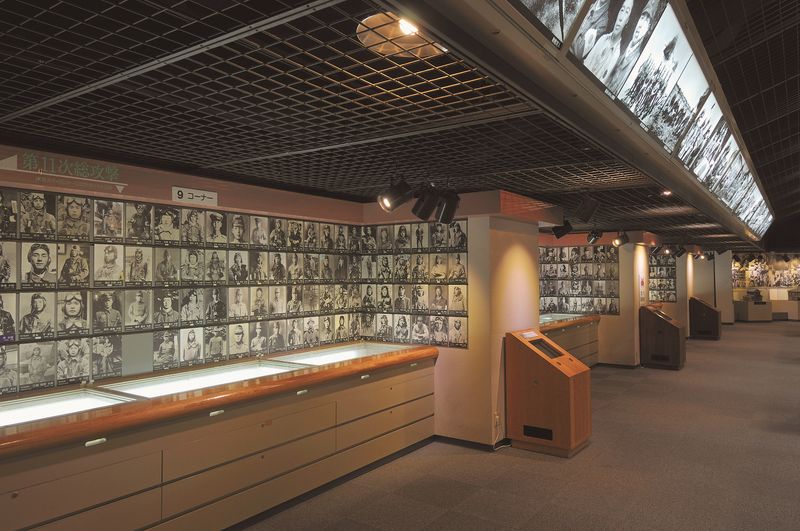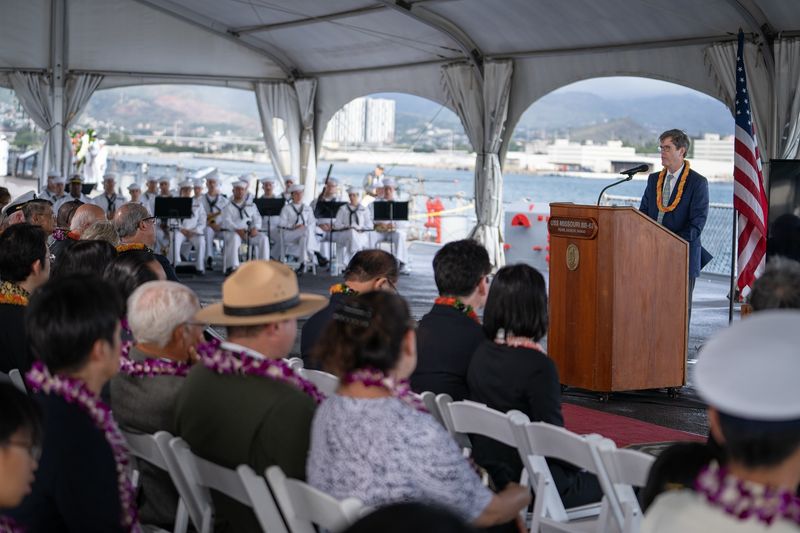War often brings out the worst in humanity, but sometimes, it reveals unexpected acts of compassion. In April 1945, the crew of the USS Missouri did something remarkable – they honored a fallen Japanese kamikaze pilot with a proper military burial at sea. This extraordinary gesture of respect toward an enemy during the height of World War II stands as a powerful reminder of our shared humanity, even in our darkest hours.
1. The Fiery Impact That Started It All
On April 11, 1945, as the Battle of Okinawa raged, a Japanese Zero slammed into the USS Missouri’s starboard side. The kamikaze attack created a spectacular fireball that lit up the morning sky, yet miraculously caused only superficial damage to the mighty battleship.
No American sailors died that day. The Missouri, nicknamed “Mighty Mo,” shrugged off what could have been a devastating blow. The ship’s thick steel armor had done its job, keeping the 45,000-ton battleship in the fight as the Pacific War reached its brutal climax.
2. A Teenage Pilot’s Final Mission
The young man who crashed into the Missouri was likely Petty Officer 2nd Class Setsuo Ishino, just 19 years old. Historical records show he belonged to Japan’s No. 5 Kenmu Squadron, one of many units tasked with suicide missions as Japan’s military situation grew desperate.
Ishino’s remains were found scattered across the deck amid twisted metal and burning fuel. His body, broken but recognizable, represented the human cost behind the anonymous enemy.
Before his mission, he had written a farewell letter to his mother expressing his determination to fulfill his duty “with a smile.”
3. Captain Callaghan’s Controversial Order
Captain William Callaghan faced a decision that would divide his crew. Standing amid the wreckage, he made an unprecedented call: “Prepare this man for burial with military honors.” His order shocked many sailors who had just watched their shipmates narrowly escape death.
What many didn’t know was that Callaghan had personal reasons to hate the enemy. His own brother, Rear Admiral Daniel Callaghan, had been killed by Japanese forces at Guadalcanal just three years earlier.
Yet something in the captain saw beyond vengeance, recognizing humanity in the fallen pilot.
4. Crafting a Rising Sun Flag From Scratch
The Missouri’s crew faced an unusual problem: they needed a Japanese flag to properly honor the fallen pilot. No American warship carried enemy flags, for obvious reasons. Sailors hurriedly gathered red and white fabric from the ship’s stores.
With careful stitching, they created a makeshift Hinomaru – the rising sun flag of Japan. This handmade flag would drape over the enemy pilot’s remains during the ceremony.
The simple act of creating an enemy’s national symbol during wartime was itself extraordinary. These men, trained to destroy anything bearing that emblem, now crafted one with their own hands.
5. The Solemn Ceremony at Sea
As the Missouri cut through Pacific waters, sailors gathered on deck. The pilot’s body, wrapped in canvas and draped with the handmade Japanese flag, rested on a wooden platform. Captain Callaghan read from the burial service: “We commit his body to the deep.”
A Marine honor guard fired three volleys – a salute typically reserved for fallen comrades, not enemies. The bugler played Taps, its mournful notes carrying across the water.
Then the weighted body slid beneath the waves. For a brief moment, these Americans had treated their enemy as they would have wanted their own dead treated – with dignity and respect.
6. Divided Opinions Among the Crew
The burial split the Missouri’s crew into opposing camps. Many sailors seethed with anger, viewing it as disrespect to American lives lost in Japanese attacks. “Why honor someone who just tried to kill us?” they asked.
Others saw wisdom in Captain Callaghan’s decision. Machinist Mate Ed Buffman later recalled, “We did what we were ordered to do. The next day you’re ready to go back and battle again.”
Over time, more crew members came to appreciate the burial as a moment when they rose above hatred. It became a point of pride that they had maintained their humanity even in war’s darkest hours.
7. A Historical First and Only
The burial aboard the USS Missouri stands as the only documented case of American forces holding a military funeral for a kamikaze pilot during World War II. Among thousands of suicide attacks, this single pilot received honors from his enemies.
Military historians have searched records extensively and found no other comparable ceremony. Other kamikaze remains were typically disposed of without ceremony or simply went down with the ships they struck.
This exceptional event highlights how individual leaders could choose compassion even within the machinery of total war. Captain Callaghan’s decision created a singular moment in military history.
8. The Pilot’s Heartfelt Final Letter
Before taking off on his final mission, Setsuo Ishino penned a goodbye letter to his mother. Researchers later discovered its contents: “Dear Mother, I will fulfill my duty with a smile. I will not return alive.”
These weren’t the words of a fanatical warrior but a young man facing death with resigned courage. His letter continued with instructions for his family and expressions of love.
Similar farewell letters from kamikaze pilots reveal they were ordinary young men caught in extraordinary circumstances. Many expressed doubt, fear, and reluctance alongside their determination to follow orders – humanizing the “enemy” Americans had been taught to hate.
9. Captain’s Personal Sacrifice Revealed
Few aboard the Missouri knew the depth of Captain Callaghan’s personal sacrifice in ordering the burial. His brother, Rear Admiral Daniel Callaghan, had died in 1942 during the Naval Battle of Guadalcanal when Japanese warships opened fire on his flagship.
William Callaghan had every reason to harbor hatred toward Japanese forces. Yet when faced with a dead enemy pilot, he chose compassion over vengeance.
Years later, crew members would learn about this family connection, deepening their respect for their captain’s moral strength. His ability to separate the humanity of individual enemies from the broader conflict showed remarkable character.
10. The Permanent Reminder on Missouri’s Hull
Visitors to the USS Missouri today can still see the dent where the kamikaze plane struck. Unlike other battle damage that was repaired, this impact mark was preserved – a permanent reminder of both the attack and the extraordinary response that followed.
The dent measures about four feet wide and sits on the starboard side, just below the main deck. Tour guides point it out as they tell the story of the burial.
This physical scar connects modern visitors to that April morning in 1945. They can touch the very spot where an enemy pilot died and where Americans responded with an unexpected gesture of humanity.
11. From Enemies to Peace Partners
The USS Missouri bookended World War II in a remarkable way. First came the enemy burial in April 1945, an act of unexpected respect. Then, just months later on September 2, 1945, Japanese officials boarded the very same ship to sign surrender documents, ending the war.
General Douglas MacArthur presided over the surrender ceremony on Missouri’s deck. The symmetry wasn’t lost on witnesses – the ship that had honored one Japanese man in death now hosted Japan’s leaders as they laid down arms.
This battleship thus became a powerful symbol of the journey from bitter conflict to eventual reconciliation between former enemies.
12. Presidential Recognition Decades Later
In 2016, President Barack Obama and Japanese Prime Minister Shinzo Abe visited Pearl Harbor together. During his speech, Obama specifically mentioned the Missouri kamikaze burial as a powerful example of humanity amid hatred.
“Even in the midst of bloody war,” Obama said, “we never lost sight of our shared humanity.” He praised Captain Callaghan’s decision as an early seed of reconciliation between former enemies.
This presidential recognition, seven decades after the event, elevated the burial from a footnote in military history to a significant symbol of American values. It demonstrated how small acts of compassion can resonate across generations.
13. Museum Partnerships Across the Pacific
Today, the USS Missouri Memorial works closely with Japan’s Chiran Peace Museum, which preserves kamikaze artifacts and tells the pilots’ human stories. This unlikely partnership bridges former enemies through shared historical understanding.
The Chiran museum, located near a former kamikaze base in southern Japan, houses thousands of farewell letters, photographs, and personal items from young pilots. Many were university students drafted into service late in the war.
Together, these museums help visitors from both nations understand the complex humanity behind the conflict. They emphasize how individual acts of respect, like the Missouri burial, pointed toward future reconciliation.
14. Farewell Letters Exhibit Moves Visitors
For the 70th anniversary of the war’s end in 2015, the USS Missouri museum created a special exhibit featuring translated farewell letters from kamikaze pilots. One particularly moving letter came from pilot Toshio Anazawa to his fiancée: “I wish for nothing other than your happiness.”
Visitors were struck by the humanity in these final writings. Rather than expressions of hatred or fanaticism, they found love letters, family concerns, and philosophical reflections on mortality.
American veterans who saw the exhibit often commented on how similar these letters sounded to what they might have written themselves. The exhibit powerfully demonstrated the shared humanity of combatants on both sides.
15. The Truth About Kamikaze Pilots
Most kamikaze pilots weren’t the fanatical warriors portrayed in movies. Historical records reveal they were primarily drafted university students, aged 18-22, with no choice but to fly suicide missions as Japan faced defeat.
Many pilots were forced to volunteer or face shame and punishment. Their private diaries and letters reveal normal young men who loved their families, had dreams for the future, and feared death.
The Missouri burial acknowledged this uncomfortable truth – that enemies are human beings caught in terrible circumstances. By honoring one pilot, Captain Callaghan recognized the humanity of all combatants, including those forced into desperate measures by their government.
16. The Chaplain’s Wise Response
When sailors grumbled about honoring an enemy, USS Missouri’s Chaplain Roland Faulk offered a perspective that silenced complaints: “A dead enemy is no longer an enemy, but simply a human being who has departed this life.”
His words cut through wartime hatred to touch on universal truths about dignity in death. Faulk reminded the crew that regardless of uniform or nationality, all deserve basic respect in death.
The chaplain’s role in the ceremony highlighted how military religious figures often served as moral compasses during war’s ethical challenges. His participation lent spiritual legitimacy to Captain Callaghan’s controversial decision.
17. A Lasting Legacy of Reconciliation
Today, tour guides aboard the Missouri museum ship tell the kamikaze burial story as a highlight of the battleship’s history. Visitors from Japan are often moved to tears learning about this gesture of respect toward their countryman.
In 2018, the mayors of Honolulu and Minamikyushu (near the kamikaze base) met aboard the Missouri to commemorate the shared history. They exchanged gifts symbolizing peace and friendship between places once locked in deadly conflict.
What began as one captain’s controversial decision has evolved into a powerful symbol of reconciliation. It reminds us that even amid history’s darkest chapters, individual choices toward compassion can echo through generations.
